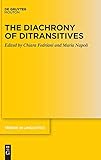The Diachrony of Ditransitives / ed. by Chiara Fedriani, Maria Napoli.
Material type: TextSeries: Trends in Linguistics. Studies and Monographs [TiLSM] ; 351Publisher: Berlin ; Boston : De Gruyter Mouton, [2020]Copyright date: ©2020Description: 1 online resource (X, 317 p.)Content type:
TextSeries: Trends in Linguistics. Studies and Monographs [TiLSM] ; 351Publisher: Berlin ; Boston : De Gruyter Mouton, [2020]Copyright date: ©2020Description: 1 online resource (X, 317 p.)Content type: - 9783110701272
- 9783110701470
- 9783110701371
- 415 23/eng/20230216
- online - DeGruyter
- Issued also in print.
| Item type | Current library | Call number | URL | Status | Notes | Barcode | |
|---|---|---|---|---|---|---|---|
 eBook
eBook
|
Biblioteca "Angelicum" Pont. Univ. S.Tommaso d'Aquino Nuvola online | online - DeGruyter (Browse shelf(Opens below)) | Online access | Not for loan (Accesso limitato) | Accesso per gli utenti autorizzati / Access for authorized users | (dgr)9783110701371 |
Frontmatter -- Preface -- Contents -- List of abbreviations -- Part 1: The nature of ditransitive arguments: the contribution of diachrony -- 1. How do ditransitives change? -- 2. Roles and grammatical relations in synchrony and diachrony: the case of the indirect object -- Part 2: Ditransitive verbs and construction alternation -- 3. The spread of the ad construction in Merovingian Latin: identifying semantic paths in the domain of ditransitives -- 4. Old Italian ditransitive constructions: between alternation and change -- 5. The emergence of the dative alternation in Dutch: towards the establishment of a horizontal link -- 6. Attraction and differentiation in the history of the English dative and benefactive alternations -- 7. The ditransitive alternation in the history of German: the case of verkaufen (‘sell’) -- Part 3: Ditransitives between stability and further developments -- 8. The diachrony of ditransitives in Vedic Sanskrit -- 9. Passives of ditransitives: the gradual rise of a Recipient passive in Italian -- 10. ‘Hit’ semantics and physical sensations: on the development of spontaneous event constructions with Spanish dar ‘give’ -- Subject Index
restricted access online access with authorization star
http://purl.org/coar/access_right/c_16ec
While ample studies exist on ditransitives in various languages, notably from a typological perspective, more work needs to be done on identifying the main processes and factors that trigger and constrain the changes they undergo over time. The goal of this volume is to help fill this gap by bringing together data and information on individual languages that have thus far been left out of the discussion and by expanding our knowledge of already studied linguistic traditions so as to achieve a broader diachronic description. Since one of the distinctive features of ditransitives is their synchronic variability in terms of structural alternation and alignment split, diachronic research can throw up new insights into developmental dynamics that are eminently complementary; namely, on the one hand, the emergence, development and loss of construction alternation and, on the other, the acquisition of new functions over time. The analyses offered in the book yield different and interconnected answers to the general question of how ditransitives change by drawing on different functional principles that play a role in the diachronic reorganization of this dynamic domain and by providing a number of original theoretical suggestions.
Issued also in print.
Mode of access: Internet via World Wide Web.
In English.
Description based on online resource; title from PDF title page (publisher's Web site, viewed 25. Jun 2024)


